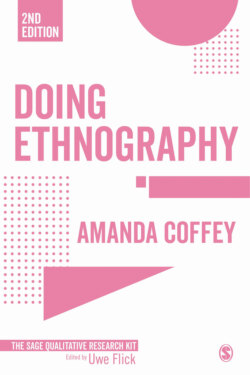Читать книгу Doing Ethnography - Amanda Coffey - Страница 25
На сайте Литреса книга снята с продажи.
Analysis and reflection
ОглавлениеIn ideal circumstances the analytical strategy or strategies should be considered as part of the research design process. Data analysis should not be seen as a distinct stage of ethnographic research, separate from the processes of data collection or theorization. Rather, analysis is integral to the ethnographic research endeavour – a reflexive activity that helps to inform data collection and drives further fieldwork. Analysis is certainly not one of the last aspects of the ethnographic research process, undertaken after data collection has ended. Rather analysis is part of research design, and might actually be undertaken before as well as during and after data collection. Ahead of fieldwork and data collection, there might be initial analyses of existing materials, documents and so on, which will enable ideas and foreshadowed problems to be developed. During fieldwork, periods for reading data and having ideas about those data should be built in. Analysis as-you-go helps to shape ongoing fieldwork, enables the researcher to progressively focus the ethnographic gaze and encourages a reflexive approach to the ethnography as a holistic research process. Hence, there should be a fluid and dynamic relationship between data collection and data analysis in ethnography.
In simple terms analysis is concerned with having ideas about the research setting (see Gibbs, 2018). In relation specifically to research design, there are choices to be made concerning the strategies that are chosen in order to undertake data analysis; techniques that permit and enable close readings of data systematically and creatively. It is possible to identify strategies for data analysis at the start of a project and indeed it is wise to at least have in mind how data will be managed during the ethnographic project. Questions about analysis that might be asked as part of the research design include: how will data be recorded and organized? How will data generated as part of the project be stored? How will data be categorized and retrieved during the project? What form or forms will data take and what options are there for analysis? What analytical strategies might work best for interview data? Field notes? Visual data? How can computer software support data analysis – and what are the opportunities and constraints of using technologies to support analysis? A preference for a particular analytical strategy might drive the ways in which data are generated and stored. For example, if there is a preference for undertaking narrative analysis, for understanding a social setting or organization through attending to narrative structures and devices, then fieldwork will similarly need to pay attention to the collection of narratives, through perhaps verbatim recording of ‘naturally occurring’ interaction, or through ethnographic interviews, or through the collection of documents generated in and of the setting. Equally, analytical strategies might emerge over the course of fieldwork, as a response to data generated in the field. For example, it may be that there are opportunities that arise during fieldwork to generate or otherwise collect photographic data that will prompt an analytical strategy that supports the analysis of visual materials; or fieldwork might reveal particular or specialized vocabularies, not anticipated at the start of the research, which suggests that a close attention to language might be helpful, perhaps including some kind of semantic analysis.
There are no right or wrong ways to analyze data from ethnographic research projects. There is variety both in relation to what is meant or understood by analysis, and also in relation to the techniques that are available to manage, store and work with ethnographic data. What is important is that early attention is paid to the possibilities of data analysis, and to attendant imperatives that analytical choices might have for fieldwork, modes of data and for the organization of data. Analysis can refer primarily to data management and data handling – incorporating tasks such as organizing, sorting, indexing, coding, retrieving and classifying data. At this level, data analysis is reliant on systematic and procedural techniques, best put in place at the outset of the project. All analysis in ethnographic research involves some kind of close and detailed reading of data, and so it is vital that early attention is given to data organization and retrieval. There should be plans put in place early on to record and store data systemically, in ways that are efficient and effective for retrieval and close working. Practically speaking, this means building into the research process times to write up or transcribe data, to upload or otherwise store data, and to add indexation or organizational tools. Moreover, this data handling work is also an important way of having regular and ongoing interaction with data and periods of reflection, which are vital to shaping ongoing and future fieldwork. Ethnographic analysis can also refer to the creative and imaginative work of the ethnographer to interpret, interrogate and speculate, to interact with but also to go beyond the data. For ethnographic research design this means being open to the creation of spaces for working with and on the data during the fieldwork process, ensuring there are times for ideas emergent from data to be developed, tested, elaborated and reworked during the research. Analysis in this sense then involves an ongoing dialogue with and between data and ideas.
